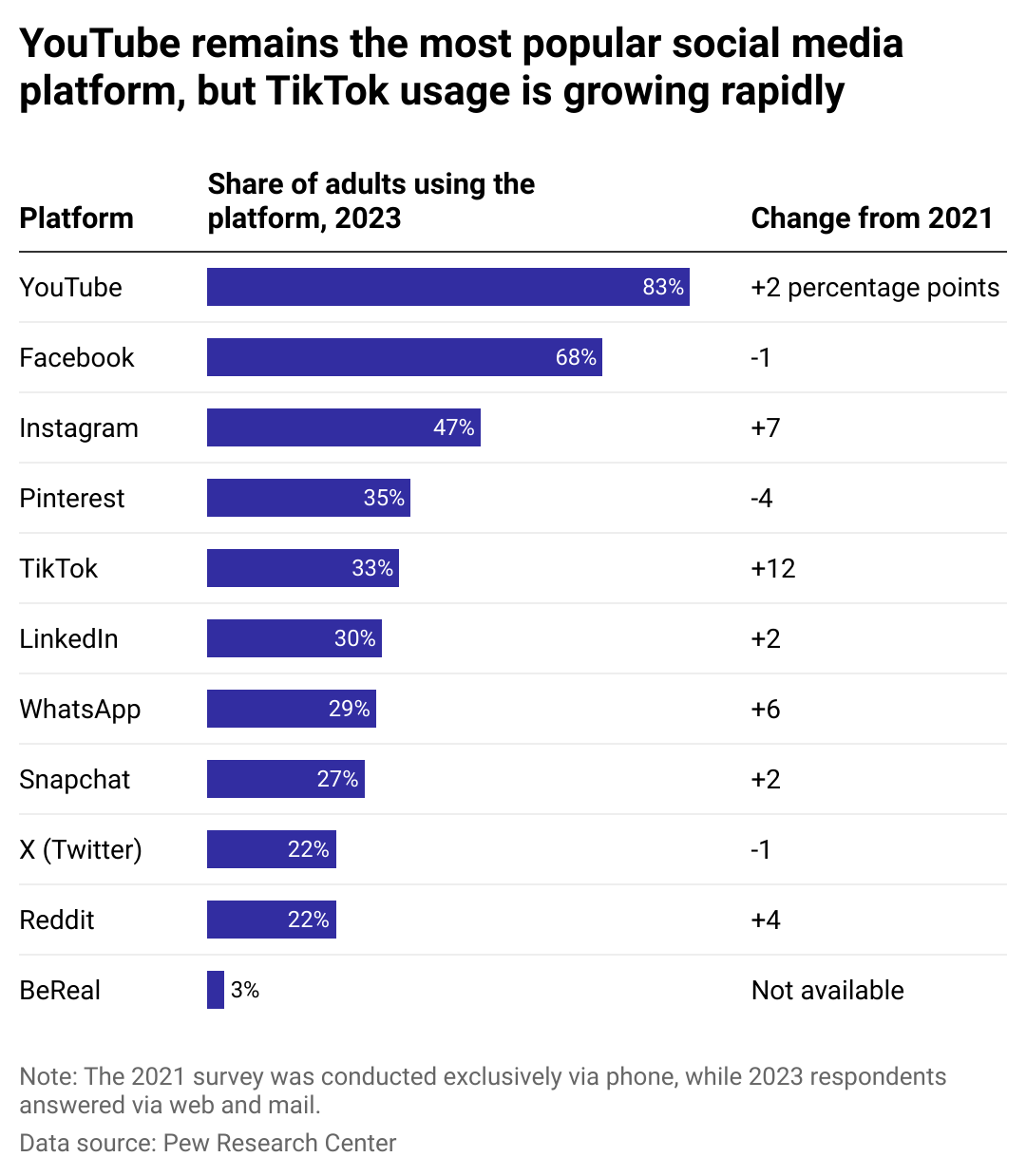The fastest-growing social media platforms in America

13_Phunkod // Shutterstock
The fastest-growing social media platforms in America
A hand holding a phone with social media on the screen.
Social media has substantially changed how people communicate, sell products and services, and tell stories—although that wasn’t necessarily the intention.
Some precursors to social media platforms, including the launch of AOL Instant Messenger in 1997 and LiveJournal in 1999, were created to support thoughtful communication between friends or discussions of niche interests with like-minded people. But as social media evolved, some platforms morphed into sophisticated machines of data collection, monetization, and algorithm-driven content.
Social media today plays a vital on- and off-screen role in the everyday lives of most Americans, thanks in part to the smartphone. People connect with friends on social media but also use these platforms to read the news, find entertaining content, and shop for items. With the ubiquity of these forums and near-universal use, social media platforms have also come under fire for spreading misinformation and conspiracies, siloing people into increasingly radical thinking, and a range of privacy issues by making it difficult for users to control how their behavioral data points are used.
Based on Pew Research Center survey data, Spokeo identified the fastest-growing social media platforms in the U.S. and explored the factors driving that expansion.
The popularity of different social media channels often depends on age, income, education, and political values, according to the Pew study. Some platforms, such as Instagram and Snapchat, are more wholly embraced by younger generations, while older generations prefer Facebook. Meanwhile, TikTok is used by 3 in 5 (62%) Americans aged 19-28 but just 34% of Americans 50 and older.
![]()

Spokeo
Video platforms top popularity and growth metrics
A table showing a bar chart with the most popular social media platforms and a column showing the percentage point growth among U.S. adults from 2021 to 2023. YouTube is the most commonly utilized platform, while TikTok is the fastest-growing platform.
While the video platform YouTube dominates the social media landscape in popularity across all demographics, TikTok is by far the fastest-growing platform for adoption among American adults. In 2021, just 1 in 5 (21%) adults said they used the short-form video platform; that number rose to 33% in 2023.
Across the globe, TikTok was the most downloaded app between 2020 and 2022, according to an Apptopia analysis of iOS + Google Play data. Unlike Facebook, new users didn’t need to “friend” people to follow them. On day one, without followers or anyone to follow, users could scroll through endless videos carefully curated by an algorithm tracking engagement based on how many likes, comments, and shares each video received.
TikTok’s user growth slowed after the company launched e-commerce in the U.S. in 2024, and users began seeing more sponsored content. That same year, the Biden administration signed legislation that could effectively ban American users from using TikTok.
While almost every major social media company grew between 2021 and 2023, Facebook, Pinterest, and X (formerly Twitter) declined in users.
Today, different platforms face different challenges. Very few social media companies at the time did what Meta, the parent company of Facebook, did in the early 2000s. MySpace profiles were easily customizable, while Facebook maintained a uniform look on its platform that felt almost democratic—everyone had access to the same look and features. It seamlessly evolved into the smartphone age while upending online advertising by creating “organic” ads that looked like user-generated content, making for a less cluttered and interactive site.
Most millennials came of age on Facebook, which launched in the early 2000s exclusively for college students and opened to the public in 2006. Facebook is still popular among those early adopters: Three in four people between the ages of 30 and 49 use the platform, according to 2023 Pew data. However, with so many social media options, Facebook struggles to retain users (save for those shopping secondhand) and inspire adoption among younger people.
As for X, market intelligence firm Sensor Tower found that the number of users has dropped by more than 20% between 2022 and 2024, coinciding with Chairman Elon Musk taking the company’s reins. Musk made a series of changes that shook up the platform, like getting rid of the traditional “verified” checkmarks for media professionals and high-profile individuals. The platform added a network for paid subscribers, which allowed them to boost their posts and comments, post up to 25,000 characters, and create an ad-revenue sharing system for creators. It’s a far cry from the egalitarian beginnings of the app.
Watchdog groups have accused X of platforming hate or inappropriate speech. It is not the only social media site called out for unsuitable content. Exposure to explicit content, harassment, and time-wasting were top social media concerns among parents of American teens, according to a 2022 Pew Research Center study.
But even content that isn’t categorized as explicit or hateful can have a detrimental effect. Algorithms that amplify inflammatory or fringe content are well-documented; for years, social media companies have grown and flourished with little government oversight. In an effort to keep users engaged, algorithms have turned these platforms into breeding grounds for extremist rhetoric, fueling disinformation, and potentially allowing foreign governments to influence elections. As a result, some users are simply abandoning these platforms altogether.
Changes to regulate social media are on the horizon. Several states have passed comprehensive data privacy laws that make it hard for social media companies to mine content and potentially sell the data to advertisers. However, there’s been some pushback among Republican-led Florida and Texas legislators, who have attempted to pass laws to preserve posts that violate companies’ social media standards, calling into question how much freedom private companies have from government regulation. Such calls for regulation and other proposed legislation and changing user behaviors will inevitably continue to shape and shift the social media landscape for years to come.
Story editing by Alizah Salario. Additional editing by Kelly Glass. Copy editing by Paris Close. Photo selection by Lacy Kerrick.
This story originally appeared on Spokeo and was produced and
distributed in partnership with Stacker Studio.